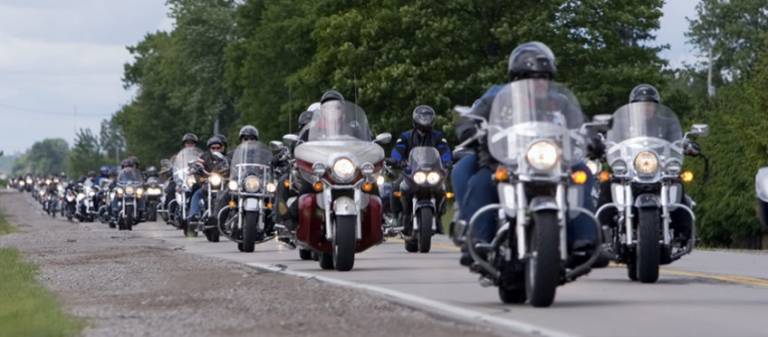Motorcycles need room for safety

“Following too closely” is a major factor in crashes involving motorcyclists, according to transportation officials in Pennsylvania, New York, and New Jersey. Motorcycles need as much distance to stop as cars.
Normally, a minimum of four seconds' distance should be maintained behind the vehicle ahead. To gauge your following distance:
Pick out a marker, such as a pavement marking or lamppost, on or near the road ahead.
When the rear bumper of the vehicle ahead passes the marker, count off the seconds: “one-thousand-one, one-thousand-two, one-thousand-three, one-thousand-four.”
If you reach the marker before you reach “four,” you are following too closely. A four-second following distance leaves a minimum amount of space to stop or swerve if the driver ahead stops suddenly. It also permits a better view of potholes and other hazards in the road.
A larger cushion of space is needed if your motorcycle will take longer than normal to stop. If the pavement is slippery, if you cannot see through the vehicle ahead, or if traffic is heavy and someone may squeeze in front of you, open up a five second or more following distance. Keep well behind the vehicle ahead even when you are stopped. This will make it easier to get out of the way if someone bears down on you from behind. It will also give you a cushion of space if the vehicle ahead starts to back up for some reason. When behind a car, ride where the driver can see you in the rearview mirror. Riding in the center portion of the lane should put your image in the middle of the rearview mirror — where a driver is most likely to see you. Riding at the far side of a lane may permit a driver to see you in a sideview mirror. But remember that most drivers don’t look at their sideview mirrors nearly as often as they check the rearview mirror. If the traffic situation allows, the center portion of the lane is usually the best place for you to be seen by the drivers ahead and to prevent lane sharing by others.
When you are being followed
Speeding up to lose someone who follows too closely only ends up with someone trying to tailgate you at a higher speed. A better way to handle tailgaters is to get them in front of you. When someone follows too closely, change lanes and let them pass. If you cannot do this, slow down and open up extra space ahead of you to allow room for both you and the tailgater to stop. This will also encourage them to pass. If they do not pass, you will have given yourself and the tailgater more time and space to react in case an emergency does develop ahead.
Lane splitting
Lane splitting refers to a motorcyclist riding between two lanes of traffic moving in the same direction. It is a controversial practice with divided opinions on its safety. The only state in which lane splitting is not illegal is California.
Lane splitting occurs on roads with at least two lanes of traffic traveling in the same direction, rather than on a single-lane road. The most common circumstance for lane splitting is in traffic when a motorcyclist rides between two lanes of stopped traffic rather than waiting in line. The smaller size of the motorcycle allows it to travel between vehicles.
New Jersey's state driver's manual warns bikers against "lane sharing" with another vehicle and specifically says "do not ride in between rows of stopped vehicles."
Do not try to squeeze past a stopped vehicle in the same lane. Anything could happen — a hand could come out of the window, a door could open or a vehicle could turn suddenly.
Discourage lane sharing by others by keeping a center lane position in situations where other motorists might be tempted to squeeze by. Moving to the far side of a lane invites lane sharing.
Riding two abreast
Another risky practice has to do with two motorcyclists riding in one lane. New York State law does not explicitly disallow this act. It only says that all motorcyclists are entitled to the full use of a lane. That means a passenger vehicle cannot encroach on a motorcyclist’s space just because he or she doesn’t take up a lot of room on the road.
Whether motorcyclists may ride two abreast in same lane is not addressed in New Jersey's administrative code or statutes.
Pennsylvania law says motorcycles shall not be operated more than two abreast in a single lane.
Sources
New Jersey Motor Vehicle Commission: state.nj.us/mvc
Pennsylvania Department of Transportation: dot.state.pa.us
New York Department of Motor Vehicles: dmv.ny.gov